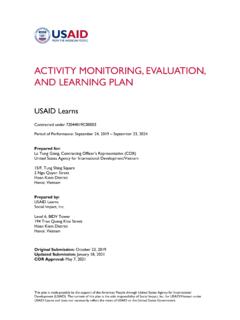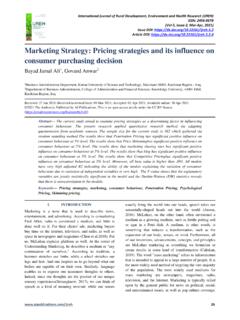Transcription of The Use of Prompting as an Evidence-based Strategy to ...
1 52 KAIRARANGA VOLUME 14, ISSUE 2: 2013 AbstrActThis article examines the use of Prompting as an Evidence-based Strategy to support children with autism to develop their language, communication and social interactions skills. The literature is reviewed using a three-ringed, Evidence-based practice model to support evaluation of the use of Prompting . The article outlines considerations about the effective use of Prompting , and some practical tools to support implementation of the effective Prompting paperKeywords: Autism, communication, Evidence-based strategies, language, promptingIntroductIonThe purpose of this article is to consider if the use of Prompting as a teaching Strategy for children with Autism Spectrum Disorder (ASD) in learning language, communication and social interaction skills is an effective support Strategy and teaching methodology in New Zealand.
2 Prompting is where an adult or peer assists a learner to acquire a new skill. Prompts can be gestural, verbal, visual, or physical. Evidence-based practice is defined in Enhancing Effective Practice: Springboards to Practice (Ministry of Education, 2005) as a procedure that is supported by research from the literature (tika); aligned with the personal skills and knowledge of the person implementing the practice (pono); and considered appropriate by family and wh anau (aroha).This article addresses each of these components in an effort to establish whether Prompting can be suggested as an appropriate procedure to be used for children with autism in New Zealand schools. It also addresses some important considerations in ensuring that children do not become over-reliant on adult writers work as a speech language therapist (SLT) with the Ministry of Education is to support children with autism and other special educational needs in attending mainstream schools.
3 This is done by working collaboratively with families, wh anau and educational teams to identify opportunities for developing specific and appropriate language, communication and social interaction goals for children. This collaboration most often takes place as part of the individual education planning (IEP) process. As a support, teams draw on the New Zealand Autism Spectrum Disorder Guideline (Ministries of Health and Education, 2008). These are a set of evidence- based practice guidelines based on research evidence. The guidelines came about following a 1988 government review of autism services which identified gaps and which formulated several recommendations to improve the quality of ASD know that about three percent of the mainstream student population have significant physical, sensory, neurological, psychiatric, behavioural or intellectual impairment (Education Review Office, 2010).
4 We also know that, as stipulated in the Education Act (1989), all children from age five can attend their local school full time and families and wh anau have the right to choose which school their child attends. The New Zealand Autism Spectrum Disorder Guideline supports this by stating that each child should be accommodated in the least restrictive setting required ( as close to a regular school setting as possible) (Ministries of Health and Education, 2008, p. 129). Whilst the approach, attitude and skills of the adults supporting the learner with autism is more important than the setting, some research suggests that children educated in regular schools make better connections (Ministries of Health and Education, 2008).In selecting appropriate communication goals for children with autism we can refer again to the New Zealand Autism Spectrum Disorder Guideline (Ministries of Health and Education, 2008) which outlines that communication, socialisation and play should be given a high priority in establishing focus learning areas ( ), and that interventions focusing on the development of communication skills should take place in natural settings, using natural routines and natural consequences ( ) (p.)
5 95). Other recommendations support The Use of Prompting as an Evidence-based Strategy to Support Children with ASD in School Settings in New Zealanddervla HayesSpeech Language Therapist, ManurewaKAIRARANGA VOLUME 14, ISSUE 2: 2013 53 Weaving educational threads. Weaving educational use of the child s usual carers, peers and teachers as instructors ( ) and the focus on spontaneity, initiation, motivation and self -management as pivotal skills ( ).This article explores the use of Prompting as a support mechanism within naturally-occurring contEXt for Prompting (tIKA)In examining the research context for Prompting the writer selected studies which met the Evidence-based criteria set out by the American National Professional Development Center (NPDC) on Autism Spectrum Disorders.
6 This is a multi-university centre established to promote the use of Evidence-based practice for children and adolescents with autism spectrum disorders. Prompting (Neitzel & Wolery, 2010) is one of twenty four Evidence-based practices endorsed by the NPDC. The NPDC describe Prompting as an adult or peer assisting a learner to acquire a new can be gestural ( , gesturing cutting when wanting the child to cut something out, or pointing to the mat when wanting the child to come to the mat), verbal ( providing an instruction Get your coat , or a lower intensity verbal prompt may be This says .. [pause]), visual ( , checklists, photos, schedules), provision of a model ( , when the verbal or visual prompt is not sufficient the adult may show the child exactly what to do - if it s a motor skill) or tell the child the answer to allow for imitation ( , It says duck ), or physical (when a child needs full or partial physical assistance to complete the skill ( , an adult puts the child s coat on for them).)
7 Prompts should be selected based on the individual needs of the learner (Bryan & Gast, 2000). They should be minimal and faded as quickly as possible (Neitzel & Wolery, 2010) so that the child learns the target behaviour independent of the adult prompt (Godby, Gast & Wolery, 1987).Four particular studies, all endorsed by the NPDC, demonstrate various Prompting methods and their effectiveness in different settings. The first of these (Taylor & Harris, 1995) evaluated the effectiveness of teaching three children with autism how to ask the question What s that? using a time-delayed Prompting procedure. The adults/instructors initially modelled the question when looking at an unknown picture or item alongside the child. They gave praise if the child imitated the question ( , saying Good asking.)
8 It s a _____. ). A time-delay was then introduced in subsequent sessions prior to modelling the question. Once the child correctly used the What s that? question prior to the model from the adult this was scored as a correct response. Success criteria was reached when the child asked the question within 10 seconds of being presented with an unknown picture during eight of ten trials over three teaching sessions. The three children in this study successfully learned to ask What s that? when seeing novel items both in structured sessions and they also generalised this to other settings (generalisation was part of the teaching Strategy ).Bryan and Gast (2000) evaluated the use of a graduated-guidance Prompting procedure to teach three children with high functioning autism to use picture schedules to remain on-task independently.
9 Following a verbal request ( , It s time to start literacy ) and a 10 second wait time, the teacher would then use a physical prompt (hand on child s shoulder) to guide the child to their picture schedule. No verbal or gestural prompts were given at any time (only physical prompts from behind the child). The number and frequency of prompts were gradually reduced until the student was successful in completing the task. The authors found the use of the graduated-guidance procedure supported all students in the study to effectively use the picture activity schedules to independently remain on , Gast and Wolery (1987) evaluated the use of either a time-delay Prompting procedure or a system of least prompts in teaching object identification to three students with severe special educational needs.
10 In the system of least prompts (sometimes referred to least-to-most prompts) a hierarchy of prompts is established, with the first level allowing the learner to respond with no prompts, and the final level ensuring success - called the controlling prompt (Neitzel & Wolery, 2010). Godby et al., (1987) showed that while both procedures were effective, the time-delay procedure required fewer sessions, and resulted in fewer and Tekin-Iftar (2008) compared simultaneous Prompting with a time-delay prompt procedure to teach young children with autism leisure skills (to use a digital camera and to turn on a CD player). They found both Prompting procedures were successful, with some suggestion that simultaneous Prompting procedure resulted in fewer errors in teaching trials, and therefore fewer lessons were needed.


















